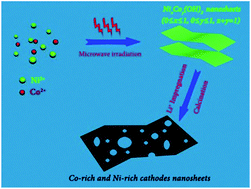A general strategy for the synthesis of two-dimensional holey nanosheets as cathodes for superior energy storage†
Abstract
Ultrathin and holey two-dimensional (2D) nanosheets are attracting extraordinary attention because of their unprecedented properties. In spite of tremendous progress on the synthesis of the 2D ultrathin nanosheets and research on their energy storage properties, up to now, the utilization of 2D holely nanosheets as cathodes remains clearly limited because of the grain growth and structural destruction. Herein, we rationally designed a general morphology-inheritance strategy to produce 2D ultrathin holey nanosheets as cathodes via a simple and scalable microwave-assisted approach. In this study, the 2D ultrathin nanosheet precursors were facilely synthesized and then, lithium and other sources were implemented to prepare ultrathin and holey 2D nanosheet cathodes (LiCoO2, LiNi0.8Co0.15Al0.05O2, LiNi0.8Co0.1Mn0.1O2, LiNi0.6Co0.2Mn0.2O2, and LiNi0.5Co0.2Mn0.3O2) through a simple solid-state reaction. The as-synthesized holey 2D cathodes present ultrahigh specific capacities, outstanding rate capability, and excellent cycle life, which are attributed to the abundant electrochemical active sites, facile interfacial transfer, and reduced diffusion distance provided by the unique hierarchical ultrathin 2D nanosheet structure with abundant atypical holes.



 Please wait while we load your content...
Please wait while we load your content...